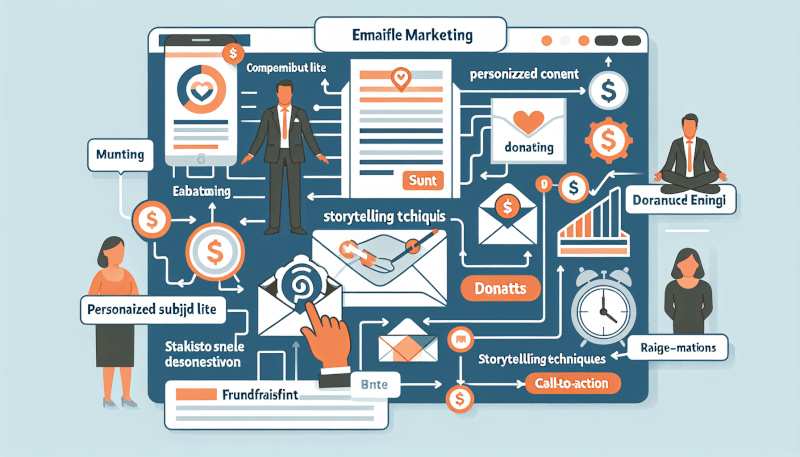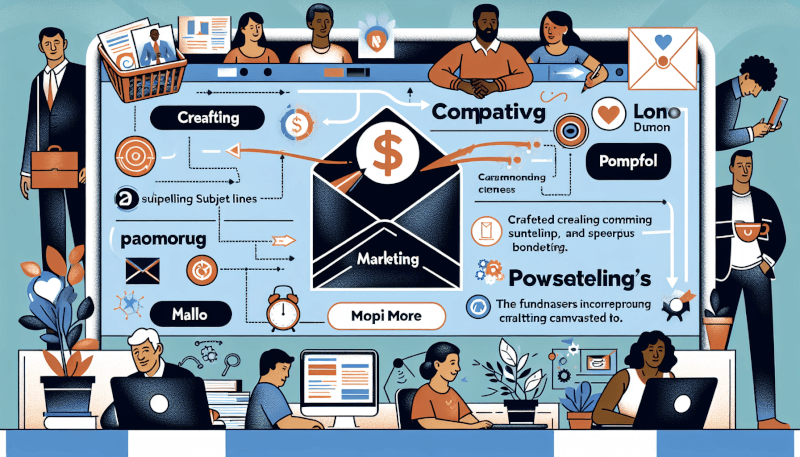Are you looking to boost your nonprofit fundraising efforts through email marketing? Look no further! In this article, we will explore the best email marketing strategies specifically designed to help nonprofit organizations achieve their fundraising goals. From creating compelling content to segmenting your email lists, we’ve got you covered. So, let’s get started and discover how to make the most of your email campaigns for nonprofit fundraising success.

1. Choosing the Right Email Marketing Platform
When it comes to nonprofit fundraising, choosing the right email marketing platform is crucial. Consider your budget and needs to determine which platform suits you best. There are numerous options available, ranging from free to subscription-based services. Remember to assess your budget and allocate funds accordingly to ensure a seamless and effective email marketing campaign.
Additionally, it’s essential to compare the features and functionality offered by different platforms. Look for features like automation, segmentation, and customization options that align with your goals and objectives. Evaluate whether the platform allows you to create visually appealing and engaging emails that can capture the attention of your target audience. By carefully assessing the features and functionality of various platforms, you can find one that meets your specific requirements.
Another important factor to consider is the deliverability rates of the email marketing platform. You want your emails to reliably reach your subscribers’ inboxes. Research and compare the deliverability rates of different platforms to ensure that your messages won’t end up in the spam folder. High deliverability rates are essential for maximizing the impact of your nonprofit fundraising campaigns.
2. Building a Quality Email List
Building an email list comprising engaged and interested subscribers is crucial for successful nonprofit fundraising. Here are some strategies to help you build a quality email list:
2.1 Create Opt-In Opportunities on Your Website
Make it easy for website visitors to opt in to your email list by strategically placing opt-in opportunities. Include enticing calls-to-action (CTAs) on your website, such as sign-up forms, pop-ups, or banners, where visitors can enter their email addresses. This way, you can capture the attention of potential donors and keep them informed about your nonprofit’s work.
2.2 Use Social Media to Gain Subscribers
Leverage the power of social media to expand your reach and gain more subscribers. Share compelling content about your nonprofit’s mission and the impact of your work on social media platforms. Encourage your followers to join your email list for exclusive updates and content. Use social media advertisements to target specific audiences and drive them to your opt-in opportunities.
2.3 Leverage Offline Events and Campaigns
Don’t limit your efforts to the online world. Take advantage of offline events and campaigns to collect email addresses. Set up sign-up sheets at fundraising events, conferences, or networking gatherings. Offer incentives, such as exclusive content or early access to upcoming campaigns, to entice people to join your email list.
2.4 Segment Your Email List for Targeted Campaigns
Segmenting your email list allows you to deliver tailored content to specific groups of subscribers. Create segments based on factors like donation history, interests, or geographic location. By sending targeted emails to each segment, you can personalize the communication and increase the chances of engagement and conversion.

3. Crafting Compelling Email Content
Now that you have a quality email list, it’s time to focus on crafting compelling content that resonates with your subscribers. Here are some strategies to create engaging and effective emails:
3.1 Write Engaging Subject Lines
Subject lines are the first thing your subscribers see when they receive an email from you. Craft subject lines that are concise, intriguing, and relevant to the content of the email. A compelling subject line can entice recipients to open your email and increases the chances of your message being read.
3.2 Personalize Emails for Individual Donors
Personalization goes a long way in building genuine connections with your donors. Address your subscribers by their first names and tailor the content to their interests or previous donation history. By making the email feel personal and relevant to each individual, you can foster a stronger bond and increase engagement.
3.3 Tell a Story that Resonates
Storytelling is a powerful tool for nonprofit fundraising. Share impactful stories about the beneficiaries of your organization’s work. Highlight the positive impact made possible by your donors’ contributions. By emotionally connecting with your readers through storytelling, you can inspire them to support your cause further.
3.4 Use Visuals and Multimedia to Enhance Engagement
Incorporate visually appealing elements into your emails to capture your subscribers’ attention. Use images, videos, infographics, and other multimedia formats to convey your message effectively. Visual content can help illustrate the impact of your nonprofit’s work and make your emails more engaging and memorable.
3.5 Include a Clear Call to Action
Every email you send should have a clear and compelling call to action (CTA). Whether it’s donating to a specific campaign, volunteering, or attending an event, guide your subscribers to take the desired action. Make the CTA prominent, using buttons or bold text, and ensure that the action is easy to complete.
4. A/B Testing to Optimize Performance
To optimize the performance of your nonprofit fundraising emails, it’s crucial to conduct A/B testing. Here’s how you can use this method effectively:
4.1 Test Different Subject Lines
Experiment with different subject lines to determine which ones yield better open rates. Test variations in tone, length, and personalization to gauge the impact on subscriber engagement. Analyzing the results of these tests can help you refine your subject lines and improve the overall performance of your email campaigns.
4.2 Experiment with Email Layouts
Try different email layouts to identify the most effective design for your audience. Test variations in email structure, formatting, and visual elements. Pay attention to factors such as readability, clarity of the message, and visual appeal. A well-designed email layout can enhance the user experience and drive higher engagement rates.
4.3 Try Different Send Times and Days
Timing is crucial when it comes to email marketing. Experiment with sending emails at different times and on different days of the week to see when your subscribers are most responsive. Monitor open rates, click-through rates, and conversion rates to identify trends and determine the optimal timing for sending your nonprofit fundraising emails.

5. Implementing Email Automation
Email automation can streamline your nonprofit fundraising efforts and save time while maintaining personalization. Here are some valuable automated campaigns to implement:
5.1 Welcome Series for New Subscribers
Create a welcome series that triggers a sequence of emails when someone joins your email list. Use this opportunity to introduce your nonprofit, share your mission, and express gratitude for their support. The welcome series helps nurture new subscribers and guides them to take further actions, such as making a donation or volunteering.
5.2 Drip Campaigns for Donor Engagement
Drip campaigns allow you to send a series of pre-scheduled emails designed to engage and nurture your donors. Plan a series of emails that provide valuable information, updates on your nonprofit’s projects, and stories about the impact of donations. Drip campaigns help keep your organization top-of-mind for your donors and encourage ongoing support.
5.3 Renewal and Upgrade Reminders
Automate reminders for donors whose contributions are nearing expiration. These automated emails can remind them to renew their donations or consider upgrading to a higher giving level. Personalize the emails based on the donor’s previous contributions and highlight the impact they have had. By automating renewal and upgrade reminders, you can enhance donor retention and increase donations.
5.4 Donor Retention and Cultivation
Implement automated campaigns to cultivate and retain your donors over time. Send regular emails that express gratitude, showcase the impact of their contributions, and update them on your nonprofit’s progress. Use automation to create personalized journeys for each donor based on their engagement history. By consistently nurturing your relationships with your donors, you can encourage ongoing support and long-term commitment.
6. Leveraging Personal Fundraising Stories
Personal fundraising stories are powerful tools for nonprofit fundraising. Here’s how you can leverage them effectively:
6.1 Share Impactful Stories from Beneficiaries
Tell the stories of individuals or communities who have directly benefited from your nonprofit’s work. Show how their lives have been positively transformed and how donor contributions have made it possible. These stories create an emotional connection and inspire donors to continue supporting your cause.
6.2 Highlight Personal Fundraising Initiatives
Feature personal fundraising initiatives undertaken by individuals who are passionate about your cause. Whether it’s a donor running a marathon or organizing a charity event, these stories demonstrate the individual impact that anyone can make. Encourage your email subscribers to join and support these initiatives, making them feel like a part of something bigger.
6.3 Use Real-life Examples of Successful Campaigns
Showcase real-life examples of successful fundraising campaigns to inspire your subscribers. Share stories of campaigns that exceeded their goals, reached new milestones, or had a tremendous community impact. By demonstrating what is possible, you motivate donors to contribute and support your own campaigns.

7. Maximizing Mobile-Friendliness
Given the increasing use of mobile devices, it’s crucial to ensure that your nonprofit fundraising emails are mobile-friendly. Here’s how you can maximize mobile-friendliness:
7.1 Optimize Emails for Mobile Devices
Design your emails with a mobile-first approach, ensuring that they are easily readable and navigable on smartphones and tablets. Use a responsive email design that adapts to different screen sizes. Optimize the font size, layout, and image dimensions to provide a seamless user experience across various mobile devices.
7.2 Use Responsive Email Templates
Utilize responsive email templates that automatically adjust the layout and design based on the device used by the recipient. Responsive templates ensure that your emails look professional and visually appealing, regardless of the screen size. This approach enhances engagement and improves the overall effectiveness of your nonprofit fundraising emails.
8. Nurturing Relationships through Email
Building and nurturing relationships with your donors is vital for long-term nonprofit fundraising success. Here’s how you can accomplish this through email:
8.1 Express Gratitude and Appreciation
Take the time to express gratitude and appreciation to your donors through email. Send personalized thank-you emails after each donation or campaign contribution. Make donors feel valued and acknowledged for their support, emphasizing the impact their contributions have made on your nonprofit’s mission.
8.2 Provide Regular Updates on Projects and Results
Keep your donors informed by providing regular updates on your nonprofit’s projects, initiatives, and outcomes. Share success stories, milestones achieved, and the tangible difference your organization is making in the community. Regular updates build credibility and ensure that your donors feel connected to your nonprofit’s ongoing work.
8.3 Show Transparency with Financial Reports
Transparency is key to building trust with your donors. Periodically share financial reports and highlight how donations are being utilized. Break down the expenses incurred and show the direct impact of donations on your nonprofit’s mission. By demonstrating financial responsibility and transparency, you reassure donors that their contributions are being utilized effectively.

9. Incorporating Social Sharing Options
Harness the power of social media by incorporating social sharing options in your nonprofit fundraising emails. Here’s how you can do it:
9.1 Include Social Media Icons in Emails
Insert social media icons in your emails, linking to your nonprofit’s social media profiles. Make it easy for your subscribers to follow your organization on popular social media platforms. This allows them to keep up with your updates, share your content, and increase the reach of your campaigns by spreading the word to their own social networks.
9.2 Encourage Donors to Share Campaigns
Encourage your donors to share your nonprofit’s fundraising campaigns with their friends, family, and colleagues. Include clear CTAs in your emails, urging them to forward the email or share it on their social media networks. Motivate them by emphasizing the collective impact that can be achieved when campaigns are shared widely.
10. Analyzing and Tracking Email Metrics
Analyzing and tracking email metrics is crucial to understanding the effectiveness of your nonprofit fundraising campaigns. Here’s what you should monitor:
10.1 Monitor Open Rates and Click-Through Rates
Track the open rates and click-through rates of your emails to gauge subscriber engagement. High open rates indicate that your subject lines are compelling, while high click-through rates demonstrate that your content is engaging. Analyze these metrics to identify trends, optimize your email strategies, and make data-driven improvements.
10.2 Track Conversion Rates and Donor Retention
Measure the conversion rates to assess how successful your email campaigns are at driving desired actions, such as donations or volunteer sign-ups. Additionally, monitor donor retention rates to ensure that your strategies are effectively cultivating and maintaining long-term relationships. By tracking these metrics, you can identify areas for improvement and implement strategies to increase conversions and donor retention.
10.3 Identify Trends and Areas for Improvement
Regularly review and analyze your email metrics to identify trends and areas for improvement in your nonprofit fundraising campaigns. Look for patterns in subscriber behavior, campaign performance, and overall engagement. Use these insights to fine-tune your strategies, test new approaches, and continuously improve the impact of your email marketing efforts.
In conclusion, implementing effective email marketing strategies can significantly enhance your nonprofit fundraising efforts. By choosing the right email marketing platform, building a quality email list, crafting compelling content, conducting A/B testing, leveraging email automation, using personal fundraising stories, maximizing mobile-friendliness, nurturing relationships, incorporating social sharing options, and analyzing email metrics, you can create impactful campaigns that resonate with your donors and drive meaningful results for your nonprofit organization.


